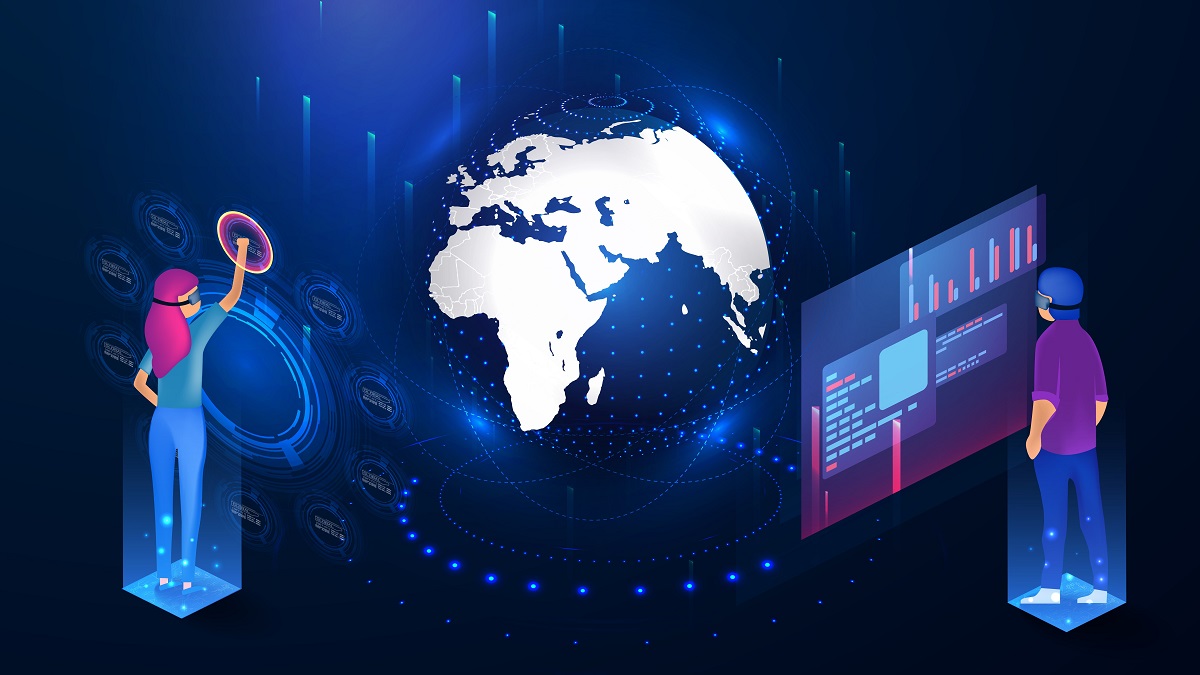The metaverse is more than just a digital playground; it’s a functioning economy where virtual goods, services, and currencies have real value. Every day, new fortunes are created in these immersive worlds, from virtual real estate millionaires to fashion empires powered by NFTs. But how do these economies work? What makes a pixelated piece of land or a pair of digital sneakers so valuable?
This article delves into the economy of the Metaverse, revealing the blockchain fundamentals that are powering this transformation, how to make money playing, and the speculative markets. Whether you’re an investor, a gamer, or just interested in the future of money, understanding these mechanics is crucial to getting ahead in the next digital gold rush—and maybe even profiting from it.
The Basics: Blockchain and Digital Ownership
Blockchain technology is the foundation of every metaverse economy. It allows people to own items digitally via NFTs (non-fungible tokens). Blockchain-backed assets can be freely bought, sold, and exchanged between virtual worlds, unlike traditional online goods that are limited to specific platforms. This makes items scarce and gives people proof of ownership, giving value to tangible treasures. When you buy a virtual Gucci bag or an NFT (non-fungible token) for a piece of land in Decentraland, you’re getting more than just pixels; you’re getting a unique, verifiable digital deed that’s stored in a ledger and can’t be changed. This dramatic shift from “permitted access” to real ownership sets the metaverse economy apart from other digital marketplaces.
Virtual Real Estate: Location Still Matters
Just like in the real world, location determines value in the metaverse. Platforms like The Sandbox and Decentraland have divided their virtual worlds into plots of land backed by NFTs. The best places to buy land are near digital landmarks, which cost more. Some investors are spending hundreds of thousands of dollars to purchase lots near virtual locations like Times Square, hoping that pedestrian traffic will generate rental income or advertising revenue. Innovative companies are even developing “meta-malls” where brands can rent virtual stores. Some see this as a speculative bubble, but others see it as the beginning of a new asset class that could create real economic prospects through the close connection of online communities and experiences.
Play and Earn: Earn Money Playing Games
The popularity of play-to-earn (P2E) games like Axie Infinity has changed the way people use virtual economies. Users don’t pay to play; instead, they earn cryptocurrency or NFTs by playing and exchanging them for real money. Some players in developing countries have earned more than their country’s minimum wage playing these games, creating an entirely new way to make money online. But the long-term viability of these models is questionable; as new players emerge, in-game economies could collapse like pyramid schemes. The next generation of P2E games hopes to create a fairer system, where talent and creativity, rather than simple speculation, determine how much money you make.
Digital Fashion and the Identity Economy:
Your avatar is no longer just for show; it’s developing into a massive industry. Digital fashion is expected to generate $50 billion in revenue by 2030. This includes Nike’s virtual shoes and Balenciaga’s clothing line in virtual universes. Limited edition NFT wearables are status symbols, with some rare NFT wearables selling for thousands of dollars. Some platforms even allow users to “rent” their digital clothing to others for a fee. This emerging industry plays on the fundamental human need for self-expression and social status and shows that people are willing to pay a high price to stand out in virtual environments.
Gold Rush for Advertising:
As millions of people spend hours in virtual universes, brands are competing to integrate their logos into them. Product placement, virtual billboards, and sponsorships are increasingly common marketing methods. Some creative marketing campaigns make it difficult to distinguish between advertising and experience. For example, people can buy an artist’s merchandise as a wearable NFT during a virtual concert. The key metric is no longer “impressions” but “immersion.” This metric focuses on the depth of consumer interaction with sponsored content, not just the number of times they view it. Early adopters of metaverse advertising have found that it works best when it enhances the experience rather than hinders it.
The Wild West of Regulations and Taxes:
Most governments are still trying to catch up with the metaverse economy, making it difficult to understand the rules. Is the cryptocurrency you earn while playing games taxable? If virtual land increases in value, is that a capital gain? In some places, certain NFT transactions are starting to be considered taxable events, while others consider them gambling winnings. The lack of clear regulation presents both opportunities (like tax havens) and risks (like rapid policy changes). As these economies develop, increased scrutiny is inevitable: savvy players will keep detailed records and prepare for future compliance requirements.
The Future: Interconnected Metaverse Economies
Most virtual worlds are currently closed economies, but the next step is interoperability, meaning assets and currencies can flow freely between platforms. Imagine wearing your Fortnite skin in Decentraland or reaching the highest level in one game to earn rewards in another. This is possible thanks to blockchain bridges and cross-Metaverse standards. They can enable a digital economy to scale beyond a single platform. This change can democratize access and liquidate markets, but it also raises some tough questions, such as how to manage shared virtual spaces, control inflation, and protect economic sovereignty.
Conclusion:
The metaverse economy is one of the most exciting changes to capitalism in the digital age. It is where imagination, technology, and market forces come together to create new ways to create wealth. While volatility and speculation are still a concern, basic concepts such as digital scarcity, verifiable ownership, and immersive interaction suggest that these economies are here to stay. As the virtual economy and the real economy become increasingly interconnected, businesses, producers, and ordinary people alike will need to understand how these systems work. The rules are still being formulated, but one thing is clear: money is about to change forever.
FAQs:
1. Is it possible to make money in the metaverse?
Yes, there are many ways to make money, such as virtual real estate appreciation, earn-while-play games, digital asset trading, and metaverse-based services. However, these methods also come with risks, and the rewards are not guaranteed.
2. How do NFTs make metaverse items valuable?
NFTs use blockchain technology to give digital products real ownership and scarcity, so they can be bought, sold, and collected just like real items.
3. Is buying virtual real estate a smart choice?
Some early investors have made a lot of money, but the price of virtual land can vary widely. The acceptance and usability of the platform determine its long-term value, making it a risky but also profitable investment.
4. What prevents the metaverse economy from declining?
To be sustainable, economies must develop balanced mechanisms and continually attract new consumers and utilities. When development stops, poorly designed models can collapse, which shows the importance of having real utility rather than just speculation.
5. How do governments regulate metaverse profits?
Tax laws are constantly changing, but in many places, tax authorities now treat Bitcoin income generated through metaverse activities as taxable income or capital gains, depending on where you live and the type of transaction.




